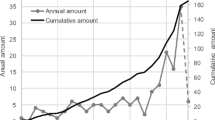Abstract
There are many available techniques which are widely used for failure probability analysis. Fault tree analysis (FTA) is a well-known method to identify the basic events (BEs) to reach top event. However, the FTA method in real circumstances is limited because of the many unknown and the vagueness of the situations. Thus, fuzzy set theory with respect to subjective expert opinion is employed to cope with the uncertain knowledge of BEs including randomness, ignorance, and shortages of data. In addition, to gain this purpose, much subjectivity may appear; as an example, the main one is the expert weighting. This study highlights the utility of fuzzy set theory and analytic hierarchy process to failure probability analysis in a case study. A chemical process plant has been selected to illustrate the application of proposed model with a comparison of the results with conventional model.




Similar content being viewed by others
References
H. Acosta, B.M. Forrest, The spread of marine non-indigenous species via recreational boating: a conceptual model for risk assessment based on fault tree analysis. Ecol. Modell. 220, 1586–1598 (2009). doi:10.1016/j.ecolmodel.2009.03.026
K. Alkhaledi, S. Alrushaid, J. Almansouri, A. Alrashed, Using fault tree analysis in the Al-Ahmadi town gas leak incidents. Saf. Sci. 79, 184–192 (2015). doi:10.1016/j.ssci.2015.05.015
J.J. Buckley, Fuzzy hierarchical analysis. Fuzzy Sets Syst. 17, 233–247 (1985). doi:10.1016/0165-0114(85)90090-9
H.K. Chan, X. Wang, Fuzzy extent analysis for food risk assessment, Fuzzy Hierarchical Model for Risk Assessment (Springer, London, 2013), pp. 89–114. doi:10.1007/978-1-4471-5043-5_6
D.-Y. Chang, Applications of the extent analysis method on fuzzy AHP. Eur. J. Oper. Res. 95, 649–655 (1996). doi:10.1016/0377-2217(95)00300-2
C.-Y. Cheng, S.-F. Li, S.-J. Chu, C.-Y. Yeh, R.J. Simmons, Application of fault tree analysis to assess inventory risk: a practical case from aerospace manufacturing. Int. J. Prod. Res. 51, 6499–6514 (2013). doi:10.1080/00207543.2013.825744
M. Gul, A.F. Guneri, A fuzzy multi criteria risk assessment based on decision matrix technique: a case study for aluminum industry. J. Loss Prev. Process Ind. 40, 89–100 (2016). doi:10.1016/j.jlp.2015.11.023
H.-M. Hsu, C.-T. Chen, Aggregation of fuzzy opinions under group decision making. Fuzzy Sets Syst. 79, 279–285 (1996). doi:10.1016/0165-0114(95)00185-9
C.-L. Hwang, K. Yoon, Multiple Attribute Decision Making (Springer, New York, 1981). doi:10.1007/978-3-642-48318-9
A. Kaufmann, M.M. Gupta, Introduction to Fuzzy Arithmetic: theory and Applications (Van Nostrand Reinhold Co., New York, 1985)
S.M. Lavasani, N. Ramzali, F. Sabzalipour, E. Akyuz, Utilisation of fuzzy fault tree analysis (FFTA) for quantified risk analysis of leakage in abandoned oil and natural-gas wells. Ocean Eng. 108, 729–737 (2015). doi:10.1016/j.oceaneng.2015.09.008
S.M. Lavasani, A. Zendegani, M. Celik, An extension to Fuzzy Fault Tree Analysis (FFTA) application in petrochemical process industry. Process Saf. Environ. Prot. 93, 75–88 (2015). doi:10.1016/j.psep.2014.05.001
A. Mentes, I.H. Helvacioglu, An application of fuzzy fault tree analysis for spread mooring systems. Ocean Eng. 38, 285–294 (2011). doi:10.1016/j.oceaneng.2010.11.003
M.R. Miri Lavasani, J. Wang, Z. Yang, J. Finlay, Application of fuzzy fault tree analysis on oil and gas offshore pipelines. Int. J. Mar. Sci. Eng 1, 29–42 (2011)
M. Nadjafi, M.A. Farsi, H. Jabbari, Reliability analysis of multi-state emergency detection system using simulation approach based on fuzzy failure rate. Int. J. Syst. Assur. Eng. Manag. (2016). doi:10.1007/s13198-016-0563-7
M. Omidvari, S.M.R. Lavasani, S. Mirza, Presenting of failure probability assessment pattern by FTA in Fuzzy logic (case study: distillation tower unit of oil refinery process). J. Chem. Heal. Saf. 21, 14–22 (2014). doi:10.1016/j.jchas.2014.06.003
T. Onisawa, Subjective analysis of system reliability and its analyzer. Fuzzy Sets Syst. 83, 249–269 (1996). doi:10.1016/0165-0114(95)00381-9
T. Onisawa, An application of fuzzy concepts to modelling of reliability analysis. Fuzzy Sets Syst. 37, 267–286 (1990). doi:10.1016/0165-0114(90)90026-3
T. Onisawa, A representation of human reliability using fuzzy concepts. Inf. Sci. (Ny) 45, 153–173 (1988). doi:10.1016/0020-0255(88)90038-2
T. Onisawa, An approach to human reliability in man-machine systems using error possibility. Fuzzy Sets Syst. 27, 87–103 (1988). doi:10.1016/0165-0114(88)90140-6
T. Onisawa, K.B. Misra, Use of fuzzy sets theory: (part-ii: applications) Chap. 14, in Fundamental Studies in Engineering, (1993), pp. 551–586. doi:10.1016/B978-0-444-81660-3.50024-1
N. Ramzali, M.R.M. Lavasani, J. Ghodousi, Safety barriers analysis of offshore drilling system by employing Fuzzy event tree analysis. Saf. Sci. 78, 49–59 (2015). doi:10.1016/j.ssci.2015.04.004
E. Ruijters, M. Stoelinga, Fault tree analysis: a survey of the state-of-the-art in modeling, analysis and tools. Comput. Sci. Rev. 15, 29–62 (2015). doi:10.1016/j.cosrev.2015.03.001
T. Runkler, M. Glesner, A set of axioms for defuzzification strategies towards a theory of rational defuzzification operators. Proc. Second IEEE Int. Conf. Fuzzy Set Syst. pp. 1161–1166 (1993)
M. Sugeno, H.T. Nguyen, N.R. Prasad, Fuzzy Modeling and Control: Selected Works of M. Sugeno (CRC Press, Baco Raton, 1999)
D. Wang, P. Zhang, L. Chen, Fuzzy fault tree analysis for fire and explosion of crude oil tanks. J. Loss Prev. Process Ind. 26, 1390–1398 (2013). doi:10.1016/j.jlp.2013.08.022
J. Wang, F. Wang, S. Chen, J. Wang, L. Hu, Y. Yin, Y. Wu, Fault-tree-based instantaneous risk computing core in nuclear power plant risk monitor. Ann. Nucl. Energy 95, 35–41 (2016). doi:10.1016/j.anucene.2016.02.024
Z.M. Xue, Research on FTA of fire and explosion in the crude oil gathering-transport combination station. Procedia Eng. 11, 575–582 (2011). doi:10.1016/j.proeng.2011.04.698
M. Yazdi, The application of bow-tie method in hydrogen sulfide risk management using layer of protection analysis (LOPA). J. Fail. Anal. Prev. 17, 291–303 (2017). doi:10.1007/s11668-017-0247-x
M. Yazdi, S. Daneshvar, H. Setareh, An extension to Fuzzy Developed Failure Mode and Effects Analysis (FDFMEA) application for aircraft landing system. Saf. Sci. 98, 113–123 (2017). doi:10.1016/j.ssci.2017.06.009
M. Yazdi, F. Nikfar, M. Nasrabadi, Failure probability analysis by employing fuzzy fault tree analysis. Int. J. Syst. Assur. Eng. Manag. (2017). doi:10.1007/s13198-017-0583-y
L.A. Zadeh, Fuzzy sets. Inf. Control 8(3), 338–353 (1965). doi:10.1016/S0019-9958(65)90241-X
R. Zhao, R. Govind, Defuzzification of fuzzy intervals. Fuzzy Sets Syst. 43, 45–55 (1991). doi:10.1016/0165-0114(91)90020-Q
Acknowledgments
The author sincerely thank the editor and the anonymous reviewers for their insights and helpful comments and suggestions which are very helpful in improving the quality of the paper.
Author information
Authors and Affiliations
Corresponding author
Rights and permissions
About this article
Cite this article
Yazdi, M. Hybrid Probabilistic Risk Assessment Using Fuzzy FTA and Fuzzy AHP in a Process Industry. J Fail. Anal. and Preven. 17, 756–764 (2017). https://doi.org/10.1007/s11668-017-0305-4
Received:
Revised:
Published:
Issue Date:
DOI: https://doi.org/10.1007/s11668-017-0305-4




